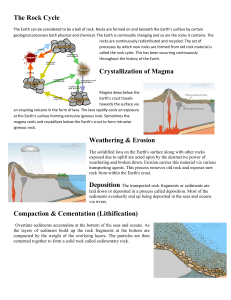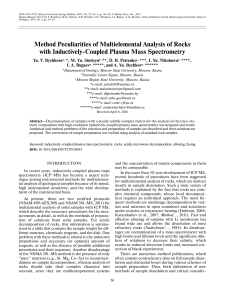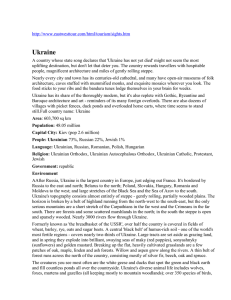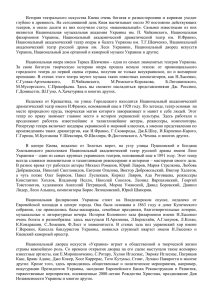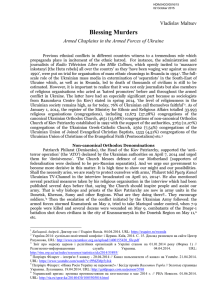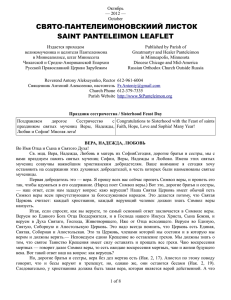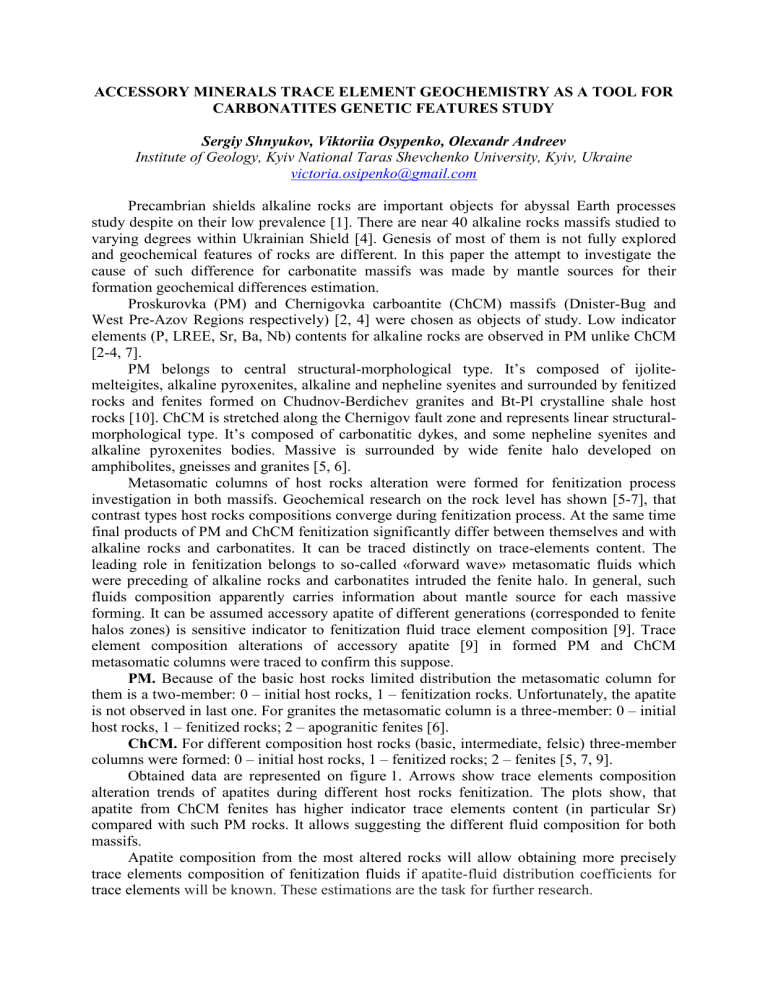
ACCESSORY MINERALS TRACE ELEMENT GEOCHEMISTRY AS A TOOL FOR CARBONATITES GENETIC FEATURES STUDY Sergiy Shnyukov, Viktoriia Osypenko, Olexandr Andreev Institute of Geology, Kyiv National Taras Shevchenko University, Kyiv, Ukraine [email protected] Precambrian shields alkaline rocks are important objects for abyssal Earth processes study despite on their low prevalence [1]. There are near 40 alkaline rocks massifs studied to varying degrees within Ukrainian Shield [4]. Genesis of most of them is not fully explored and geochemical features of rocks are different. In this paper the attempt to investigate the cause of such difference for carbonatite massifs was made by mantle sources for their formation geochemical differences estimation. Proskurovka (PM) and Chernigovka carboantite (ChCM) massifs (Dnister-Bug and West Pre-Azov Regions respectively) [2, 4] were chosen as objects of study. Low indicator elements (P, LREE, Sr, Ba, Nb) contents for alkaline rocks are observed in PM unlike ChCM [2-4, 7]. PM belongs to central structural-morphological type. It’s composed of ijolitemelteigites, alkaline pyroxenites, alkaline and nepheline syenites and surrounded by fenitized rocks and fenites formed on Chudnov-Berdichev granites and Bt-Pl crystalline shale host rocks [10]. ChCM is stretched along the Chernigov fault zone and represents linear structuralmorphological type. It’s composed of carbonatitic dykes, and some nepheline syenites and alkaline pyroxenites bodies. Massive is surrounded by wide fenite halo developed on amphibolites, gneisses and granites [5, 6]. Metasomatic columns of host rocks alteration were formed for fenitization process investigation in both massifs. Geochemical research on the rock level has shown [5-7], that contrast types host rocks compositions converge during fenitization process. At the same time final products of PM and ChCM fenitization significantly differ between themselves and with alkaline rocks and carbonatites. It can be traced distinctly on trace-elements content. The leading role in fenitization belongs to so-called «forward wave» metasomatic fluids which were preceding of alkaline rocks and carbonatites intruded the fenite halo. In general, such fluids composition apparently carries information about mantle source for each massive forming. It can be assumed accessory apatite of different generations (corresponded to fenite halos zones) is sensitive indicator to fenitization fluid trace element composition [9]. Trace element composition alterations of accessory apatite [9] in formed PM and ChCM metasomatic columns were traced to confirm this suppose. PM. Because of the basic host rocks limited distribution the metasomatic column for them is a two-member: 0 – initial host rocks, 1 – fenitization rocks. Unfortunately, the apatite is not observed in last one. For granites the metasomatic column is a three-member: 0 – initial host rocks, 1 – fenitized rocks; 2 – apogranitic fenites [6]. ChCM. For different composition host rocks (basic, intermediate, felsic) three-member columns were formed: 0 – initial host rocks, 1 – fenitized rocks; 2 – fenites [5, 7, 9]. Obtained data are represented on figure 1. Arrows show trace elements composition alteration trends of apatites during different host rocks fenitization. The plots show, that apatite from ChCM fenites has higher indicator trace elements content (in particular Sr) compared with such PM rocks. It allows suggesting the different fluid composition for both massifs. Apatite composition from the most altered rocks will allow obtaining more precisely trace elements composition of fenitization fluids if apatite-fluid distribution coefficients for trace elements will be known. These estimations are the task for further research. Figure 1. Composition variations of accessory apatites from PM (a) and ChCM (b) fenite halo rocks [9]. 1-3 – basic (1), intermediate (2) and felsic (3) host rocks; 4-9 – their metasomatic alterated products (4, 6, 8 – fenitized rocks; 5, 7, 9 – fenites); 10 – alkaline syenites; 11 – nepheline syenites; 12 – ijolites; 13 – apatite composition fields boundaries. Arrows show composition alteration trends of apatites from fenite halos rocks. Statistic justified fields of apatite compositions are marked by roman numerals (from [8]): I – metamorphic carbonate and silica-carbonate rocks; II – calc-alkaline ultrabasic, basic and intermediate rocks; III – the same for moderately felsic rocks; IV – high-felsic granites; V – carbonatites, alkaline rocks and associated metasomatic rocks (together with mantle xenolithes lherzolites); VI – alkaline metasomatites (including fenites). References 1. Igneous rocks. Vol. 2. Alkaline rocks. M., 1986. (In Russian). 2. Kryvdik S. G. Alkaline magmatism of Ukrainian Shield: geochemical and petrogenetical aspects // Mineral. Journal. 2000. Vol. 22. № 2/3. P. 48-56. (In Ukrainian). 3. Kryvdik S. G., Dubyna O. V. Alkaline rocks geochemical features of Dnister-Bug of Ukrainian Shield // Mineral. Journal. 2006. Vol. 28. № 4. P. 32-42. (In Russian). 4. Kryvdik S. G., Tkachuk V. I.,. Petrology of Ukrainian Shield nepheline rocks. K.: Nauka, 1990. 406 p. (In Russian). 5. Nykanorova Yu. Ye., Shnyukov S. Ye., Lazareva I. I. Metasomatic zoning geochemical features of Ukrainian Shield, Yenisey Range and Voronezh Massif linear carbonatite massifs // The Ural Mineralogical School. Ekaterinburg, 2013. P. 94-99. (In Russian). 6. Osypenko V. Yu., Shnyukov S. Ye., Nykanorova Yu. Ye. Fenitization halo geochemical zoning as an evaluation criterion of abyssal fluids composition and their ore-forming potential // International Scientific Conference «Metasomatism and Ore-formation». Kyiv, 2016. P. 51-53. (In Ukrainian). 7. Shnyukov S. Ye. Fenitization process features of Chernigovka carbonatite massif (West Pre-Azov Region) // Geol. Journal. 1983. Vol. 43. № 4. P. 52-61. (In Russian). 8. Shnyukov S. Ye. Geochemical classification of zircons and apatites from main types of rocks and ores: current situation, application and development procpects // Geol. Journal. 2003. № 1. P. 99-103. (In Russian). 9. Shnyukov S. Ye., Lazareva I. I. Associative zircons, apatites and titanites admixture elements as formational affiliation and metasomatic zoning criterion // Geol. Journal. 2003. № 2. P. 107-112. (In Russian). 10. Tsarovskiy I. D., Bratslavskiy P. F. Dniester-Bug region nepheline rocks (geology, age and material composition). K., 1980. 46 p. (In Russian).
